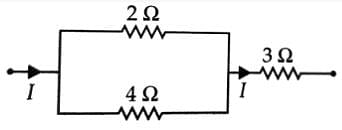Test: Electrical Energy & Power (NCERT) - NEET MCQ
5 Questions MCQ Test NCERTs at Fingertips: Textbooks, Tests & Solutions - Test: Electrical Energy & Power (NCERT)
If voltage across a bulb rated 220V, 100W drops by 2.5% of its rated value, the percentage of the rated value by which the power would decrease is
Four wires of the same diameter are connected, in turn, between two points maintained at a constant potential difference. Their resistivities and lengths are; ρ and L (wire 1), 1.2ρ and 1.2L (wire 2), 0.9ρ and 0.9L (wire 3) and ρ and 1.5L (wire 4). Rank the wires according to the rates at which energy is dissipated as heat, greatest first,
A heater coil is rated 100 W, 200 V. It is cut into two idential parts. Both parts are connected together in parallel, to the same source of 200 V. The energy liberated per second in the new combination is
In the circuit shown in figure heat developed across 2Ω, 4Ω and 3Ωresistances are in the ratio

Two 2Ω resistances are connected in parallel in circuit X and in series in circuit Y. The batteries in the two circuits are identical and have zero internal resistance. Assume that the energy transferred to resistor A in circuit X within a certain time is W. The energy transferred to resistor B in circuit Y in the same time will be
|
257 docs|234 tests
|










 = 400Ω
= 400Ω
























